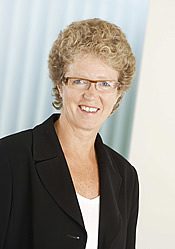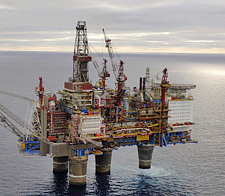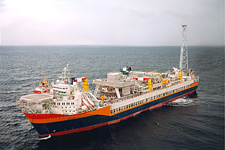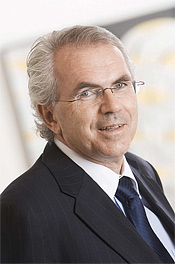
Executive vice president Hilde Merete Aasheim.
The proposed new organisation model will now be discussed with all the employees’ unions in the central union-management committee of StatoilHydro.
The goal of the restructuring and integration work is to create a real integration of Statoil and Hydro’s oil and gas activities and also to develop a new, common culture throughout the group.
“The purpose of this stage of the integration work is to strengthen the operational parts of StatoilHydro’s activities, create a common culture and make full use of the combined knowledge and experience the group possesses,” Hilde Merete Aasheim, who is leading the integration and restructuring work.
“The integration process is an important tool to improve operations and strengthen our focus on health, safety and environment on platforms and onshore facilities,” she says.
“We will achieve this by applying best practice from both organisations and establishing more standardised work processes across the organisation.”
Planning of the integration and restructuring work has been led by a group of representatives of the group's top management and the unions. Thorough impact assessments of alternative solutions have been made during the process.
Agreement has been reached with all the unions in the integration team on the models chosen for gas processing plants, refineries and terminals.
With regard to a new organisational solution for the offshore activities and base operations, Industri Energy, Norwegian Society of Engineers (Nito) and the Norwegian Society of Chartered Technical and Scientific Professionals (Tekna) are positive to the proposed solution, but will not give their final reply before the impact assessment has been completed.
The Norwegian Union of Energy Workers (Safe)/Confederation of Vocational Unions (YS) has stated that the union does not support the proposed operational model.

The Gullfaks A platform in the North Sea (Photo: Øyvind Hagen)
A final decision on a new organisational model will be made by the group after the employee representatives have had the opportunity to present their views on the proposed model.
StatoilHydro aims to complete the final formal processing during June 2008. The tempo of the restructuring work will be determined by the requirement for safe and efficient operations.
This stage of the restructuring work covers the parts of the group’s activities that were not affected by the integration process in 2007. Close to 7,300 employees are affected by this stage of the integration.
The first stage of the integration process began before the establishment of StatoilHydro on 1 October 2007 and included around 9,000 employees.
The model chosen gives the employees security:
- All employees are ensured a job in the new organisation
- All employees on an offshore contract will keep their contract if they prefer. All employees on onshore facilities will keep their employment at the facility
- No employees will be forced to move to a different geographical location (place of residence)

The Åsgard A FPSO in the Norwegian Sea (Photo: Øyvind Hagen)
“The management and the unions have had common goals for the integration and restructuring work,” says executive vice president Hilde Merete Aasheim.
“We have had a good cooperation on finding solutions that will strengthen StatoilHydro. I would like to commend the employee representatives for a very constructive contribution in this thorough process which started in December 2007. They have given important input to the solutions chosen.”
Natural gas and processing plants and terminals
In the Natural Gas and the Manufacturing & Marketing business areas, organisational solutions have been developed to strengthen the basis for safe and efficient operation of the gas processing plants at Kårstø and Kollsnes and the processing plants and terminals at Mongstad, Tjeldbergodden, Kalundborg and Sture.
The restructuring will further clarify the interfaces with other business areas as well as the roles and responsibilities and the same tasks will be performed in the same way on all onshore facilities.
This will improve work efficiency and reduce operational costs. Improved efficiency and savings will benefit the owners of the plants and create a more flexible and robust organisation with increased opportunities for StatoilHydro’s employees.
Using the expertise and experience on all offshore installations
The restructuring of StatoilHydro’s offshore operations is based on an extensive analysis embracing all the group’s installations.
Representatives of management and employees from all involved units and installations have contributed in the process.
The merged StatoilHydro is one of the world’s largest offshore operations organisations. During around 40 years, the group has developed a business consisting of 31 installations on the Norwegian continental shelf and a unique basis of experience and knowledge for offshore operations.
The extent of the group’s offshore activities forms the basis for exchange and learning across the organisation with a view to improve our safety level and develop new operational modes which lay the foundation for optimal use of the petroleum resources.

Tore Torvund, executive vice president for Exploration & Production Norway.
”Our analyses and experiences from the recent serious incidents show that we have a substantial improvement potential in parts of our activities,” says Tore Torvund, executive vice president for Exploration & Production Norway.
“At the same time, there are major differences between the various units with regard to organisation, work processes for daily operation and results. Our goal is to utilise the experience and knowledge in our organisation to establish a common culture and common work processes. The changes we will make are important to maintain StatoilHydro’s position as the best operator in all phases of the activities on the Norwegian continental shelf.”
Increased focus on maintenance
The company will introduce a new and more consistent organisation of the company’s offshore operations with common work processes, compliance with best practice, clearly defined roles and responsibilities, and good planning and maintenance management.
StatoilHydro will take care of all management functions and ordinary operations and maintenance tasks offshore itself.
The relationship between tasks performed by the company’s employees and those performed by contractors will largely remain the same as today.
StatoilHydro will maintain its own catering personnel on platforms using this model today.
The new organisation is particularly designed to increase the priority of operating tasks and maintenance, while establishing a more systematic and methodical organisation of non-critical maintenance tasks. All safety-critical functions will be performed on the individual installation.
Most employees in the offshore organisation will still belong to a specific installation, but arrangements will be made for a greater degree of flexibility and mobility of personnel between the installations within the three operating areas on the Norwegian continental shelf.
”The purpose of the organisation model for maintenance is to increase the focus on maintenance that is critical to safety and production, and increase the company’s ability to mobilise resources for important maintenance tasks in a flexible way. Another aim is to increase the long-term regularity of the maintenance work,” Torvund says.
It is also recommended that offshore engineer positions in the future be included in StatoilHydro’s onshore organisation. If the number of tasks that require engineering skills so require, engineers may be on an offshore rotation schedule.
The goal is to improve the interaction with the rest of the onshore organisation and suppliers, and to ensure a more useful distribution of the tasks between the offshore and onshore organisations.
Minor changes will be made to the organisation of the company’s logistics functions.
Instruments
”The restructuring process will release capacity in the company and form the basis for a more optimal use of the company’s combined skills. The released capacity will be addressed by introducing a voluntary early retirement programme and strengthening priority tasks offshore,” says Hilde Merete Aasheim.
Employees who turn 58 by 31 December this year will be allowed to take early retirement on the same conditions as the employees covered by the first part of the integration process. 225 employees at gas processing plants, refineries and terminals will be entitled to this programme. On offshore installations and supply bases the number is about 700. Early retirement may be taken from 1 April 2009 at the earliest.
The company finds it fully possible to ensure safe and effective operations of the company’s offshore activities, even if everyone were to accept the offer.
In order to stimulate real integration the employees in the offshore operations will be allowed to report an interest in minimum two positions in the new organisation.
Employees who report an interest in a position on a new installation will receive a lump-sum payment of NOK 60,000. Programmes to compensate for relocation of positions from offshore to onshore, and any changes to the rotation programme, have been established in consultation with the employees. Skills development programmes for the employees will also be established.